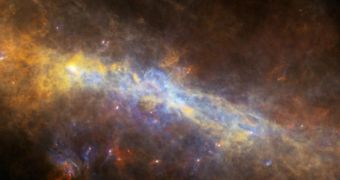Using the most complex telescope in space, experts were recently able to identify a massive ring of dense gas at the core of the Milky Way. The structure stretches for more than 600 light-years, and was never before seen in its entirety.
Previous studies revealed some portions of the structures, but it took the resolving power of the European Space Agency's (ESA) Herschel Space Observatory to fully make out its shape and size.
The existence of this bizarre, twisted ring baffled astronomers, who currently have no models that could explain why such a structure exists at this location. The new studies were conducted in infrared wavelengths, the team behind the work says.
Herschel's main instruments operate in infrared and sub-millimeter light, and are among the most complex and advanced ever constructed. The telescope itself is a marvel of engineering, far more advanced than anything in space today.
Details of the research efforts were published in a recent issue of the esteemed Astrophysical Journal Letters. The team writes that Herschel is the natural selection when it comes to seeing the coldest objects or structures in the Universe.
“We have looked at this region at the center of the Milky Way many times before in the infrared. But when we looked at the high-resolution images using Herschel’s sub-millimeter wavelengths, the presence of a ring is quite clear,” explains scientist Alberto Noriega-Crespo.
He holds an appointment as an investigator with the NASA Infrared Processing and Analysis Center, at the California Institute of Technology (Caltech), in Pasadena. The expert is also a coauthor of the study.
“This is what is so exciting about launching a new space telescope like Herschel. We have a new and exciting mystery on our hands, right at the center of our own galaxy,” adds Institute of Space Physics in Rome expert Sergio Molinari, the lead author of the paper.
The ring structure is made up of a giant tube-like formation comprising cold hydrogen gas, mixed with cosmic dust. Within it, numerous hydrogen clouds are collapsing to form new, blue stars.
“Astronomers were shocked by what they saw – the ring, which is in the plane of our galaxy, looked more like an infinity symbol with two lobes pointing to the side,” a NASA press release explains.
“In fact, they later determined the ring was torqued in the middle, so it only appears to have two lobes. To picture the structure, imagine holding a stiff, elliptical band and twisting the ends in opposite directions, so that one side comes up a bit,” the document concludes.
Experts now plan to conduct more in-depth studies of this peculiar galactic feature. Understanding it could also shed more light on how galaxies and their black holes grown and evolve.

 14 DAY TRIAL //
14 DAY TRIAL //